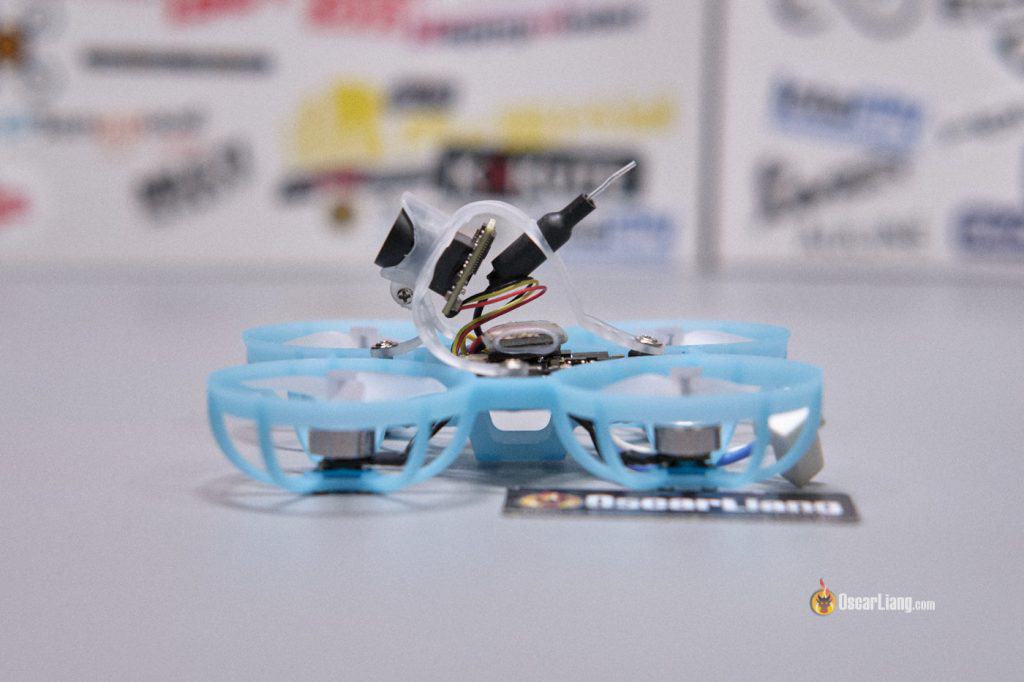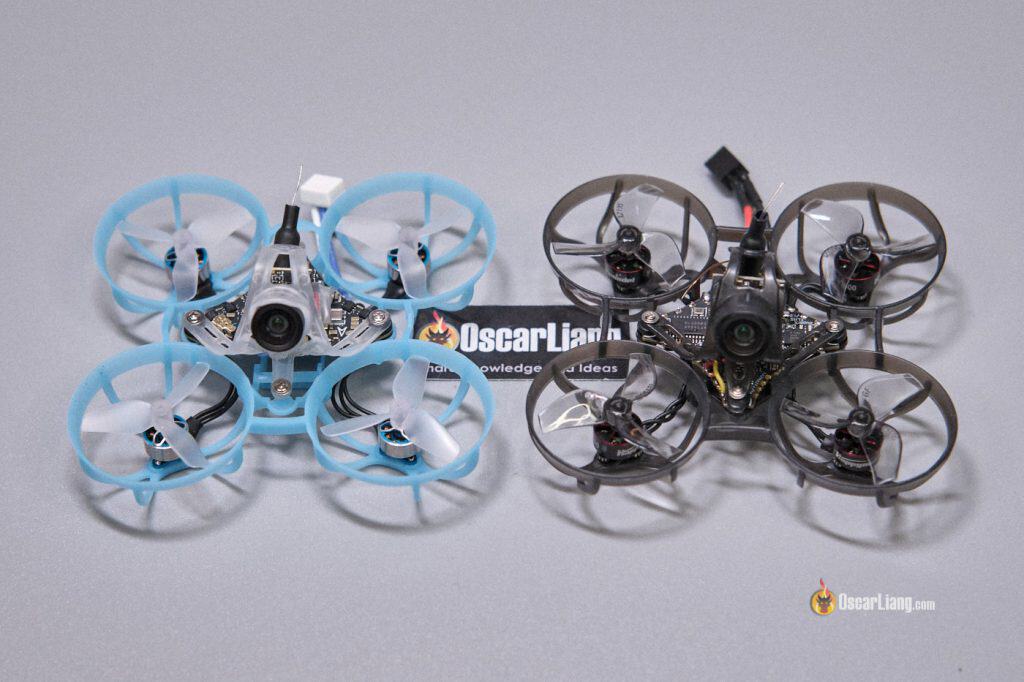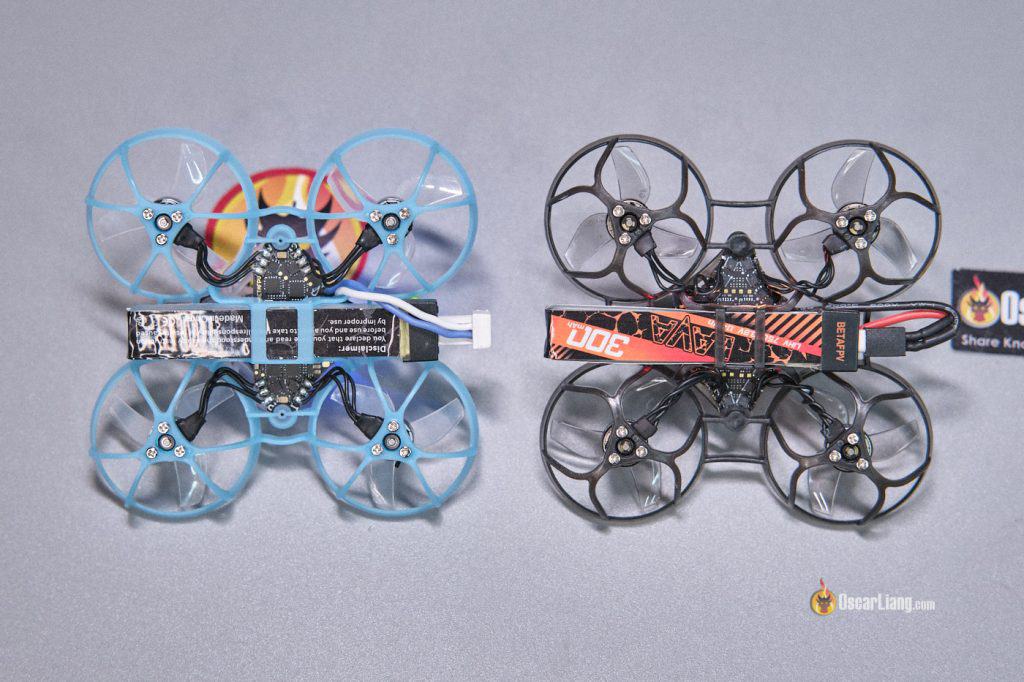It’s been five years since BetaFPV released their last Tiny Whoop, the Meteor65. Now, BetaFPV has finally unveiled the Air65, a new 1S 65mm Tiny Whoop. Designed to cater to both freestyle and racing pilots, the Air65 comes in two flavours, each offering an ultra-lightweight build and different power systems to suit various flight styles. In this review, we’ll dive into the hardware and flight performance, and see how it compares to the popular Mobula6 2024. I will also share my custom PID and filter tune for optimized flying experience.
Here are the Tiny Whoop parts and accessories I recommend: https://oscarliang.com/best-tiny-whoop/
Where to Buy?
You can get the BetaFPV Air65 Tiny Whoop from:
There are two versions, freestyle and racing. Not sure which one to get? I will talk about it later in this review to help you decide.
- Freestyle Edition: Features 23000KV motors paired with HQ 31mm Ultralight propellers.
- Racing Edition: Equipped with 27000KV motors and GF 1219S-3B propellers.
Opening the BetaFPV Air65 package, you’ll find:
- The Air65 1S 65mm Tiny Whoop drone
- A set of spare propellers
- USB-C Adapter for configuring the drone
- User manual available online via a QR code
Note: The battery is not included. Get the recommended BetaFPV LAVA 1S LiHV here:
Specifications
Here’s a comparison of the BetaFPV Air65 with the previous Meteor65.
| Specification | Air65 | Meteor65 |
|---|---|---|
| Weight (w/o battery) | 17.1g | 22.8g |
| Prop Size | 65mm | 65mm |
| Frame | Meteor65 Air Frame | Meteor65 Frame |
| Canopy | Micro Air Canopy | Micro Canopy 2022 |
| FC & ESC | G4 Air FC | F4 1S 5A AIO FC |
| VTX | Integrated 5.8GHz VTX (400mw) | M03 VTX (25mW) |
| Camera | C03 Camera | C03 Camera |
| Motors | 0702SE 23000-27000kv | 0802SE 19500kv |
| Propeller | GF 1219S-3B / HQ 31mm Ultralight | GF 31mmx3 |
| Battery Connector | BT2.0 | BT2.0 |
| Battery | LAVA 1S 260mAh/300mAh 75C | 1S 300mAh 30C |
| Flight Time | 2.5 to 4 mins | 4mins |
| RX | PNP/ELRS |
Flight Controller specs:
- MCU: STM32 G473
- Gyro: ICM42688-P
- Supports Betaflight OSD
- 16MB Flash memory for Blackbox logs
- 4 UARTs
- Integrated 5.8GHz 400mW Analog VTX
- Integrated 4-in-1 5A ESC
- Solder pads for motors
Closer Look
The Air65 boasts an ultra-lightweight design, weighing merely 17.1 grams without battery, making it one of the lightest BNF tiny whoops I’ve tested so far. This lightweight design enhances maneuverability and responsiveness.
The drone comes in two versions: Freestyle and Racing, each equipped with different KV motors and propellers to suit various flying styles.
| Freestyle | Racing | |
| Motors | 0702SE 23000kv | 0702SE 27000kv |
| Propellers | Gemfan 1219S-3 | HQ 31mmx3 Ultralight |
The lower 23000KV gives you longer flight time (about 30 to 40 seconds more on average on 1S 300mAh), while the 27000KV offers more power and responsiveness. If you can’t decide which version to get, I’d recommend the Racing Edition. The higher 27000KV motor KV is becoming the new standard in tiny whoop racing, making your whoop feel more agile and powerful. If you find it too fast, you can always reduce its power by setting a lower motor output limit or scaling down your throttle.
The C03 FPV camera offers decent performance in a well-lit environments, however it might not be the best in low light.
The flight controller is the new G4 Air FC with a G473 processor and ICM42688P gyro, proving to be reliable in my two weeks of testing. This AIO FC integrates the FC, 4-in-1 ESC, OSD, and 400mW VTX. However, it doesn’t have an integrated ExpressLRS receiver, so you will find an external RX mounted on the FC. The Air65 FC offers 4 UARTs, a current sensor, and 16MB memory for Blackbox! Those are fantastic features to have on a tiny whoop, and very rare. I think this FC is a good choice if you plan to build a tiny whoop from scratch. The flight controller is available here: https://oscarliang.com/product-dhlc.
What’s interesting is that the USB port can power the VTX without a battery! That’s useful when troubleshooting and setting up the drone as you don’t need to plug in your battery.
One of the biggest criticisms I have about the BetaFPV Air65 is its camera angle. I find even the lowest camera angle too high, making it hard to maneuver indoors in tight spaces.
I wish the adjustment belt at the rear of the canopy was longer and had perhaps a couple of extra holes to allow a lower angle, which could be beneficial for beginners.
For now, I came up with a workaround by removing the screws at the rear and attaching the canopy using a zip tie. This effectively lowers the camera angle, without introducing any vibration or jello, and doesn’t seem to reduce durability either.
Comparing Air65 to Mobula6 2024
The Mobula6 2024 has been one of the most popular tiny whoops since its release earlier this year. Despite some hardware and quality control issues, the features and performance it offers are just revolutionary.
The BetaFPV Air65 has its own issues, as mentioned in this review, but it does have better hardware quality control in my opinion. There are pros and cons to these models, and I will break them down here.
Note that the Mobula6 comes with two sets of spare props (12 props in total) while the BetaFPV only comes with one set (8 props in total). Come on BetaFPV, give us one more set! 🙂
Weight
Weighs at only 17.1g, the Air65 is about 0.5g lighter than the Mobula6, mainly due to the lightweight FC design, which has a more compact diamond shape. BetaFPV also replaced the USB port with a small plastic JST connector to further reduce weight. The downside is that you have to use a USB-C adapter when connecting to Betaflight, which could be annoying for some, but personally, I have not found that to be an issue. You do have to remember to bring the adapter with you if you are traveling with the Air65, or else you can’t access Betaflight Configurator.
Frame Design
Frame and canopy designs are highly similar between the BetaFPV Air65 and Mobula6 2024, but the canopy plastic used in the Air65 is wider, which contributes to its better durability. Durability has been an issue in the Mobula6, as the canopy doesn’t hold up with extensive use and crashes. So far, the canopy in the Air65 has been holding up really well for me. The other difference is the camera mounting, where the Air65 is friction-mounted in the canopy using just one screw, while in the Mobula6, the camera is mounted using two screws on the back of the camera. This doesn’t seem to make a huge difference TBH.
When it comes to frame and canopy, there are many different colors you can choose from.
Motors
Both the Air65 and Mobula6 use 0702 motors, which is the standard for 65mm tiny whoops nowadays. The Mobula6 motors have a 28000KV, similar to the Air65 Racing Edition’s 27000KV, while BetaFPV also offers the Freestyle Edition with a much lower 23000KV.
I really like the motors in the Mobula6 as they seem to have more grip in the air and are slightly more responsive. It’s a subtle feeling, but I think one of the reasons behind this could be the magnets – the Mobula6 motors have curved magnets while the Air65 just has regular magnets.
Personally I’d recommend the high KV version. It’s definitely not the most efficient, but it’s just more powerful and fun to fly. Regardless of your flying style and levels, if you want to go slower, you can always lower the motor output or scale down throttle in Betaflight or in your radio. I have a guide here: https://oscarliang.com/reduce-power-throttle-taranis-betaflight/
I find setting a motor output limit of around 85% on the 27000KV matches the power of the 23000KV, but somehow I still feel the 27000KV is more agile.
Battery
The 90-degree angled battery plug of the BetaFPV is such a nice touch and indeed more user-friendly. BetaFPV uses BT2.0 connectors, while the Mobula6 uses A30. While they are different connectors, they are semi-compatible; it just takes a bit more force to plug and unplug them. The Mobula6 has a straight connector which puts a lot of stress on the solder joints when using long 300mAh packs, and the leads are too short to get the battery in the center which potentially impacts weight distribution.
Between the LAVA 1S 260mAh and 1S 300mAh battery packs, I’d recommend the 300mAh. Although the 260mAh is slightly lighter, it noticeably loses punch in the second half of the pack, and the weight saving and increase in flight performance isn’t enough to justify the flight time loss in my opinion. I tested these batteries here: https://oscarliang.com/whoop-toothpick-lipo-battery/#1S-LiPoLiHV
Image Quality
The FPV camera in the Air65 works brilliantly in a well-lit environment. When flying at night with lights on, it clearly outperforms the Mobula6 – it feels brighter, and the image seems clearer. However, in low light conditions (e.g., during the day with curtains drawn), the Mobula6’s camera provides a better image than the Air65. I can’t call a clear winner here as they excel in different lighting conditions.
Flight Performance
I must admit, out of the box, the Mobula6 2024 edition flew better with its stock tune (though it’s by no means the best tune and still has room for improvement). The Air65 came with a custom PID/filter tune but it felt loose and not as locked in. However, after some in-depth tuning, the Air65 can definitely match the performance of the Mobula6, if not surpassing it. I will put my tuning and settings below in this review so you can try it. It flies so much better, more responsive and locked in.
Here’s the flight times tested with their default settings (aggressive style flying at constant 50-60% throttle) and their respective hover throttle:
| Freestyle Edition | Racing Edition | |
| 1S 260mAh | 4:00 | 3:40 |
| 1S 300mAh | 4:30 | 4:00 |
| Hover Throttle (300mAh fully charged) | 35% | 30% |
How to Set Up for First Flight
The FC comes with Betaflight 4.5.0, and the FC target is BETAFPVG473. You can find the default CLI diff here.
Firstly, bind the receiver,
Receiver firmware target is BETAFPV 2.4GHz Lite RX. Follow this guide if you don’t know how: https://oscarliang.com/bind-expresslrs-receivers/
For maiden flight, here are the Betaflight configurations:
- Load ExpressLRS Preset
- Set Your Rates
- Enable Telemetry
- Set Arm switch, angle mode switch, turtle mode switch
- Set OSD (disable “Core Temperature” under warnings)
Advanced Tuning and Settings
If you want to improve the Air65’s flight performance and have a better experience, here are my recommendations:
- In Power & Battery, set Minimum Cell Voltage to 3.0V, Warning Cell Voltage to 3.2V. Set Scale from 750 to 720 under Amperage Meter.
- Reduce Angle strength to 90, or even 75 based on your taste, 100 just feels too rigid.
- Set Angle Limit to 60 (this basically controls the your roll/pitch stick responsiveness).
- Motor idle 7%.
Reflash Bluejay: They already come with Bluejay 0.19 flashed, but with 96KHz PWM Frequency. You can flash them to a lower PWM frequency for more motor braking power, which would make the quad more responsive at the cost of flight time. If you suffer from vibration issues with 24KHz, try 48KHz or just leave it at 96KHz. ESC Firmware Target: A-X-5.
You will get less flight time when going down in PWM frequency, but the quad will feel more responsive and tighter around turns. I think 48KHz is a good balance. Here are the average flight times with different PWM frequencies with 1S 300mAh (constant 50-60% throttle aggressive flying):
- 96KHz: 4:00
- 48KHz: 3:40
- 24KHz – 2:50
PID Tuning
Filter Tuning:
Reduce RPM filtering:
Set rpm_filter_weights = 100, 60, 0
save
My rates for Angle Mode:
I am writing a post on the best tiny whoop settings which I will publish in the next day or two, stay tuned.
Conclusion
The BetaFPV Air65 1S 65mm Tiny Whoop is an impressive addition to the FPV hobby. Its ultra-lightweight design, powerful motors, and advanced flight controller make it a versatile choice for pilots of all skill levels.
You can get the BetaFPV Air65 Tiny Whoop from:
It’s easy to set up and flies well. I think BetaFPV has better quality control and hardware than the Mobula6, but I’d definitely encourage you to put better settings and tune on this whoop to optimize performance. For me, it’s probably the best Tiny Whoop in 2024 in terms of hardware and features.
























